
Pothos are easily our #1 favorite houseplant and the golden pothos is by far the most popular variety. They’re loved by beginners and plant experts alike because they’re affordable, attractive, and easy to care for. They’re quick-growing plants with beautiful trailing vines that add loads of life and color to any space. We have pothos in nearly EVERY room of our house!
There are over a dozen kinds of pothos (Epipremnum aureum), most of which share similar characteristics and care instructions as the golden pothos. You can read more about other varieties we love, like the marble queen pothos and neon pothos.
Golden Pothos Quick Facts
Here’s what you need to know about your golden pothos at a glance:
- Latin name: Epipremnum aureum
- Common names: Golden pothos, devil’s ivy, devil’s vine, hunter’s rove
- Mistaken for: Neon pothos, marble queen pothos
- Light: Prefers medium, indirect light but is low-light tolerant
- Watering: Every 7-10 days during its growing season, or if the soil is dry & leaves are drooping
- Soil: Standard potting mix as long as it drains well
- Ideal Humidity: Average household humidity, ideally 50-70%
- Ideal Temperature: 65-85 degrees
- Cold Hardiness: USDA Zones 10-12
What Is A Golden Pothos?
Golden pothos is an evergreen vine sometimes called “devil’s ivy” or “devil’s vine” because it’s seemingly impossible to kill. It’s known to stay alive and happy, even in a room without a lot of light. This resilience is one reason it has become one of the bestselling houseplants. They’re sold everywhere from nurseries, home improvement centers, and even grocery stores. We bought our first one at Kroger!
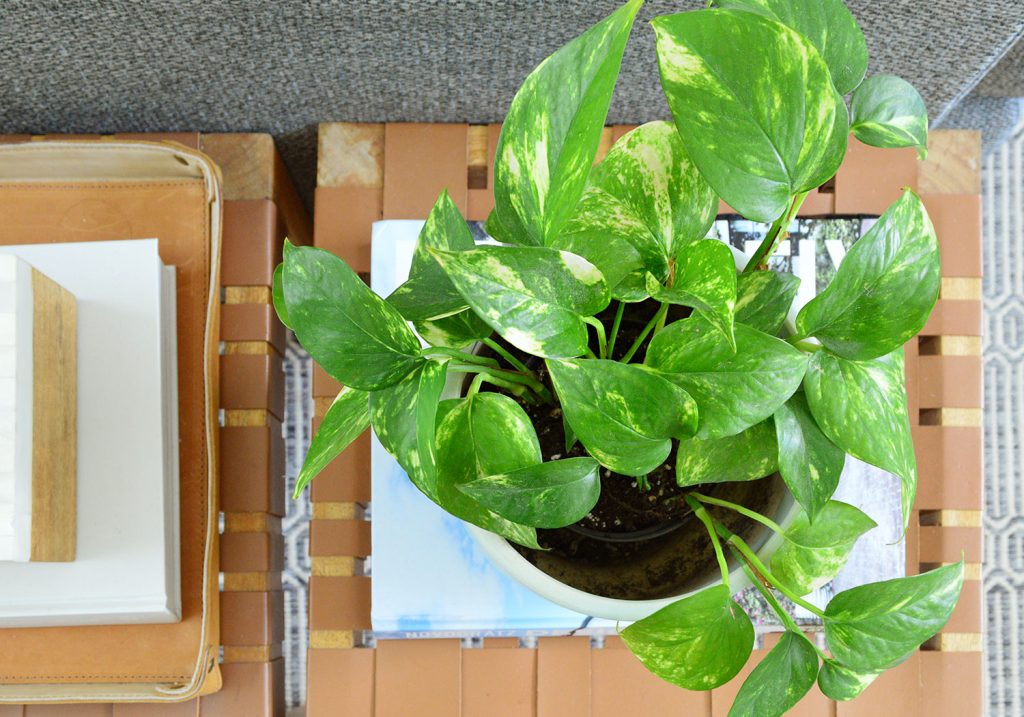
We love them because they’re easy to care for and grow long, dramatic vines that look great trailing down from a shelf, windowsill, or hanging basket. You can also add a stake to make them climb up something vertically. They can add over 12″ of length to their lush trailing vines in just one month!
Golden vs. Marble Queen vs. Neon Pothos
Some species of pothos can be difficult to tell apart, especially since coloring and pattern can change depending on environmental conditions. Golden pothos typically have green heart-shaped leaves with yellow or golden variegations. In fact, the “aureum” part of its scientific name means “golden.” In lower-light situations, there may be fewer or no golden flecks that are visible.
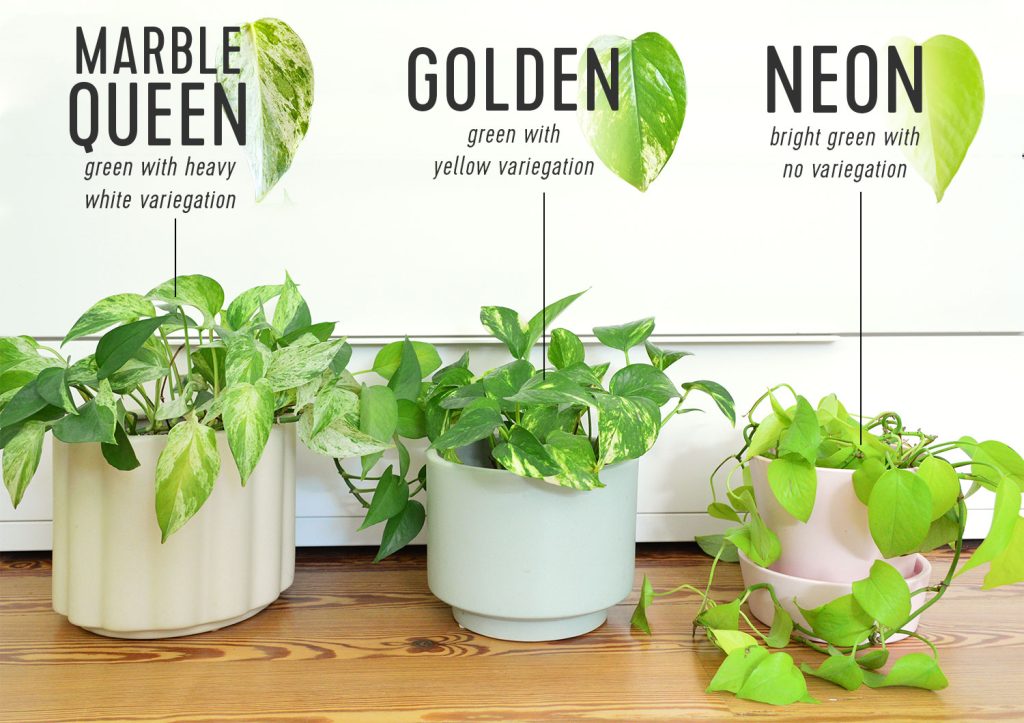
Golden pothos are easy to confuse with two other popular varieties of pothos: marble queen pothos and neon pothos. We have all three of these varieties in our home and even our plant identifier apps get them wrong sometimes! They all have similar, heart-shaped leaves but their colorings differ slightly, as you can see here:
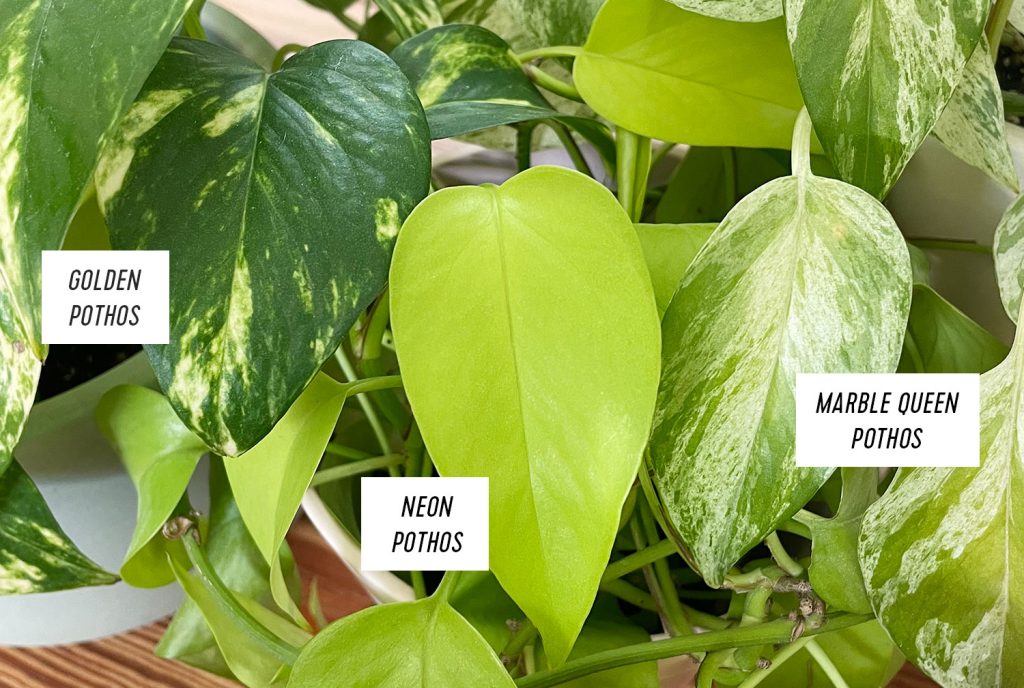
Marble queen pothos leaves tend to be darker green with white or cream variegations (aka, less yellow). The marble queens we own also tend to have a higher concentration of variegation on each leaf.
Neon pothos tend to be a brighter, more “neon” green without variegation. These can be difficult to distinguish from golden pothos plants without heavy variegation patterns, especially because any new growth tends to have that bright neon color!
How To Care For A Golden Pothos
Golden pothos can tolerate a wide variety of light and watering conditions, which makes them low-maintenance and low-stress. They make great entry-level plants for people just starting to learn how to care for houseplants. And because they grow quickly, they’re very rewarding to care for. You’ll feel like a plant expert in no time. We love to give them as housewarming gifts for this reason!

How much light do they need?
Golden pothos can handle nearly any lighting situation from dark or low-light corners, to bright & sunny spots. It can even survive in artificial fluorescent light. The more light your pothos receives, the faster and fuller it will grow. Just avoid too much direct sunlight since it can burn the leaves.
How much water do they need?
We water our golden pothos every 7-10 days during its growing season (spring & summer). They need less frequent watering in the fall or winter. Pothos plants begin to droop when thirsty, so you can also just keep an eye out for this visible cue. Don’t worry, they will perk up shortly after watering. Just don’t let them get crispy and dry. Also avoid overwatering, since this can rot the roots.
What soil do they like?
Golden pothos do great in standard potting mix. When repotting, just be careful not to compact it too much. Pothos prefer well-draining soil because sitting in moisture can cause root rot. Try adding perlite or lava rock to help it stay well-aerated.
Do they need to be pruned?
In addition to plucking off dead leaves, you may need to prune a pothos occasionally to control its size or shape. Pruning is best done in the springtime. Use clean sharp shears to cut a little bit above a node (where a leaf attaches to the vine). You can prune as much length as you’d like, but try to leave at least a couple of inches above the soil line. Each cut is an opportunity for new healthy growth and can help your pothos grow bushier.
When do I repot my pothos?
Pothos may require repotting to a larger pot every 1-2 years, depending on their growth. This gives your plant more room to grow healthy roots and the new soil provides fresh nutrients. Some people repot plants immediately after purchase, however this may shock a plant that is already adjusting to a new environment. Alternatively, you can wait a few months or until you see indications of it becoming rootbound in its current pot.
How To Propagate A Golden Pothos
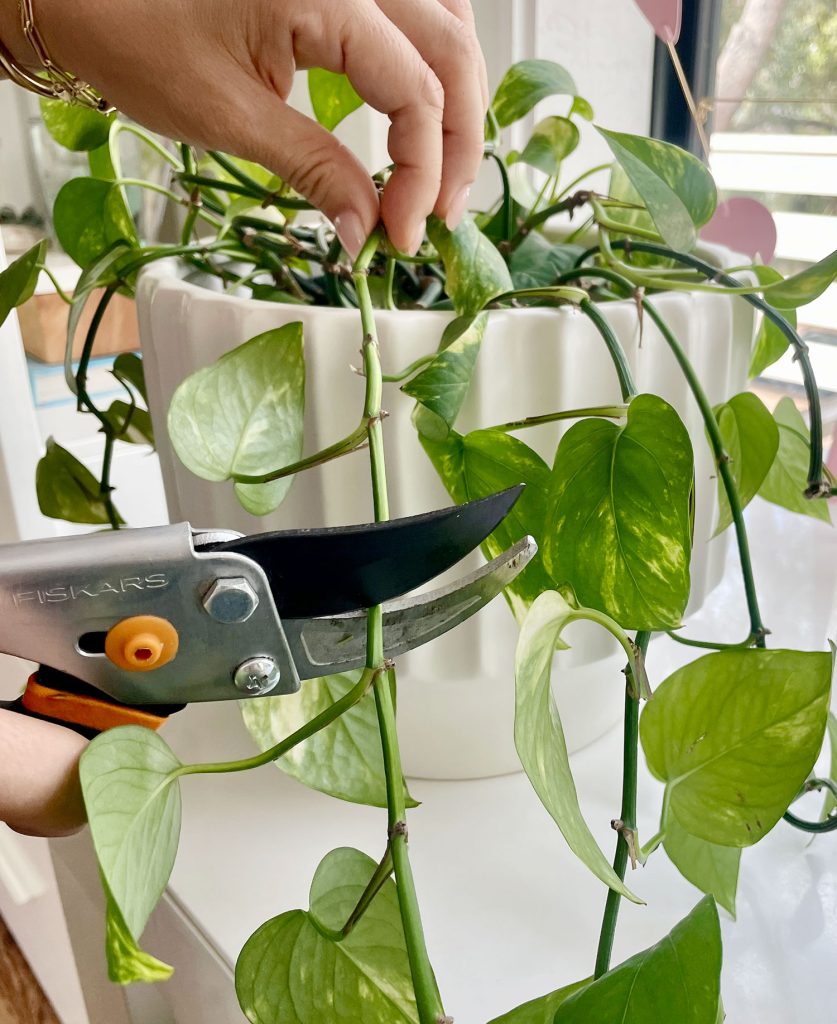
Pothos are also a great houseplant to learn how to propagate. Propagation is when you use a cutting from an existing plant to grow a whole new plant that you can pot separately. Any time you prune a pothos is a great opportunity to propagate a new one!
Step 1: Take a vine cutting
Use sharp clean clippers to cut a pothos vine above a node, leaving at least 3 or 4 leaves below the cut. Consider taking multiple cuttings at once to propagate several new pothos at once!
Step 2: Place the clipping in water
Fill a clear cup or vase with clean tap water. Put the cut end of your pothos vines inside, making sure no leaves are submerged. You can remove lower leaves if needed. Find a partially sunny spot to place your vessel.
Step 3: Once rooted, transfer to soil
Roots may appear in as little as a week or two. We like ours to grow a couple of inches before transferring them into soil. Pot them in standard potting mix and you’re good to care for it just as you would a mature plant!
Common Golden Pothos Issues
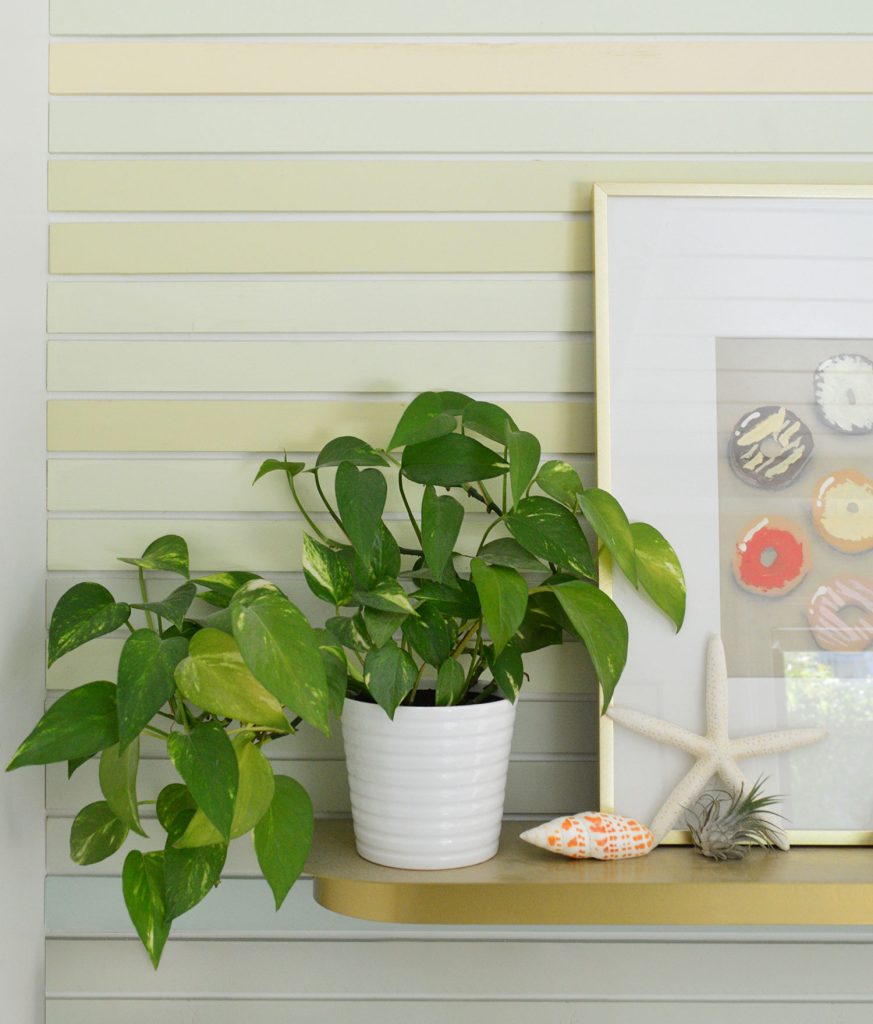
Like all houseplants, pothos are susceptible to common issues. Luckily a golden pothos is pretty good at telling you what it needs and we find they’re usually quick to recover. Again, they aren’t called devil’s ivy for nothing!
- Yellowing leaves: Pothos leaves naturally yellow as they shed, so don’t be alarmed by a yellow leaf here and there (they can usually be pulled off by hand at the node). Widespread yellowing, however, is cause for concern. This is likely due to overwatering and could be a symptom of root rot. Space out your regular waterings more or use less water.
- Brown or crispy leaves: This could be due to underwatering, low humidity, or too much direct sunlight. Try watering or misting your pothos, or move it to a lower-light location.
- Drooping leaves: Your pothos is thirsty! Water it like normal and they should perk up within the day.
- Foul smell: This could be a sign of root rot. This occurs when soil is kept too moist. Some pothos don’t recover once root rot has set in, but you can try to rescue your plant by repotting it into fresh soil. Remove the rotted roots in the process.
- Pests: Pothos don’t tend to have lots of pest issues, but if you see any bugs they can typically be removed with water and then the plant can be treated with a natural neem oil application.
Other Golden Pothos FAQ
Are golden pothos toxic to cats?
All pothos are considered toxic to cats, dogs, and humans if ingested. While the plant doesn’t contain any poison, its leaves and stem contain an undigestible mineral called calcium oxalate. The sharp crystals can cause irritation to the body’s soft tissue, although typically effects are mild. Still, it’s safest to keep your pothos out of reach of any pets or children who may nibble on it.
Can golden pothos be outdoors?
Yes! Golden pothos can be grown outdoors in USDA Plant Hardiness Zones 10-12. They can also be kept outside in other areas during the warmer months and brought in during the winter. We do this with the several pothos we keep outdoors in hanging containers. For instance, we use them in our outdoor shower and on our outdoor plant shelf.
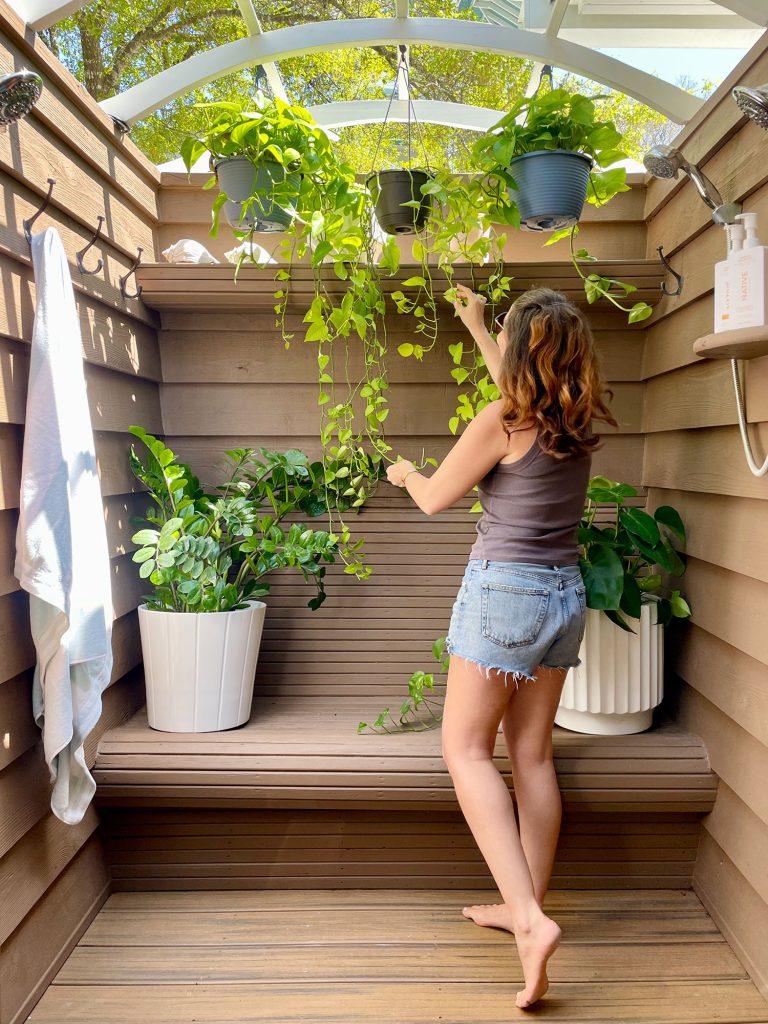
What other pothos are there?
Golden pothos are the most popular type of pothos, but there are more than a dozen varieties. Some other favorites of ours are marble queen pothos and neon pothos. Together with golden pothos, they make a beautiful collection on a shelf due to their unique variations in color, pattern, and leaf shape. You may also see manjula pothos, cebu blue Pothos, snow queen pothos, jade pothos, and baltic blue pothos.
Can pothos be grown in water?
Golden pothos can be kept in water instead of soil, although there is no benefit to one versus the other. Some people choose water because they like to watch the roots grow or as a semi-aquatic plant for aquariums. To grow a pothos in water, use a fresh vine clipping as you would for propagation and be sure to change its water frequently.
More Plant Guides
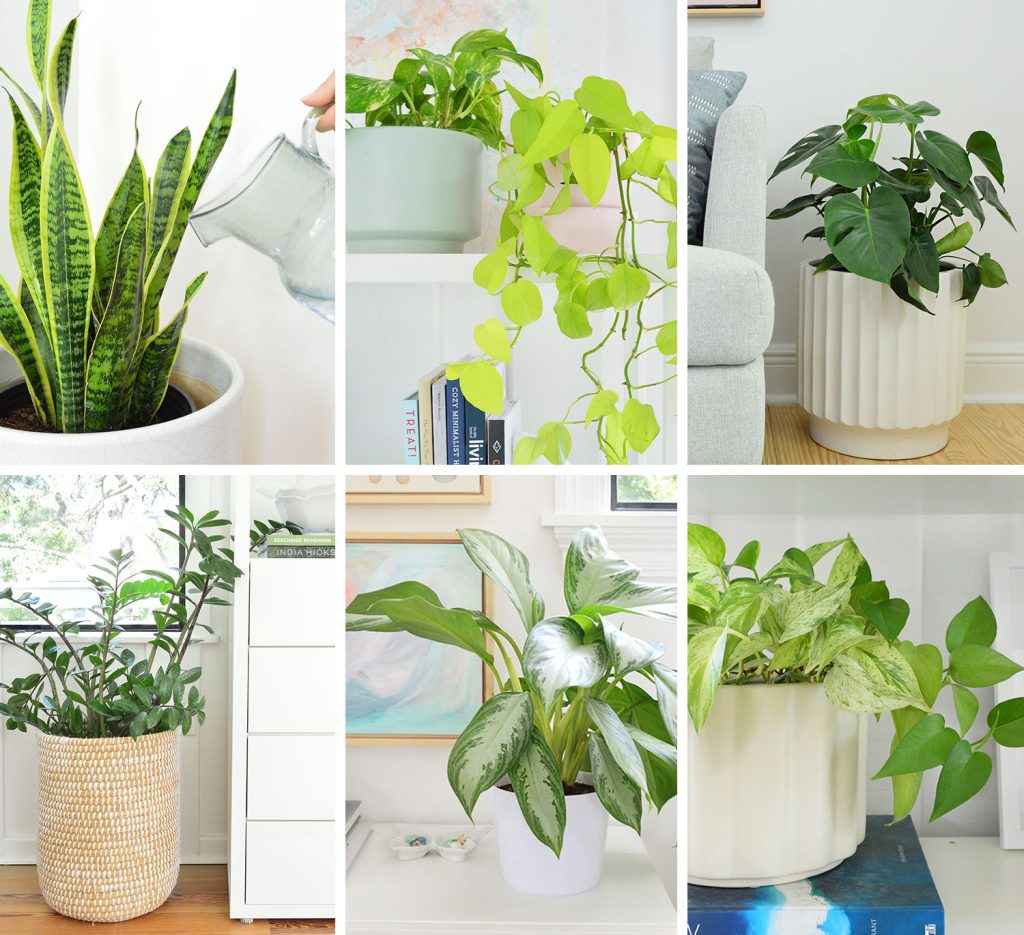
If you’re looking for more information on some of our favorite plants (real and faux!) check out some of these posts below:
*This post contains affiliate links, so we may earn a small commission when you make a purchase through links on our site at no additional cost to you.
More posts from Young House Love
Disclaimer: all images are owned and copyright by their respective owners and website (www.younghouselove.com) and “https://madcityhomeimprovement.com/blog” is for news, information, product news and reviews.






